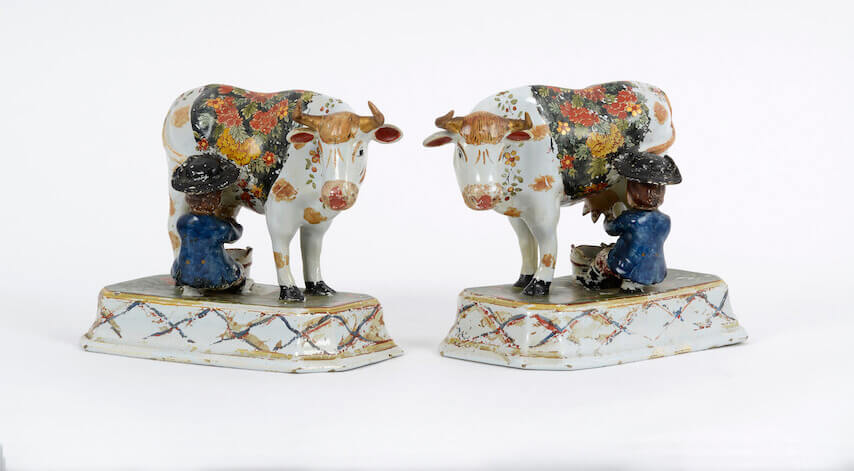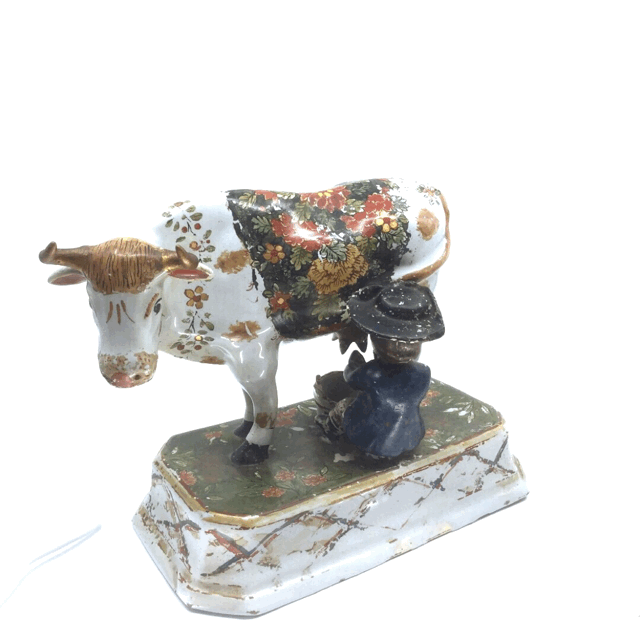
[popup_trigger id=”13756″ tag=”span”]![]() [/popup_trigger]
[/popup_trigger]
Images on this website are licensed under a
Creative Commons Attribution-NoDerivs 3.0 Unported License.

OBJECT
D1964. Pair of Polychrome Cold-Painted Milking Groups
Delft, circa 1775
Each modeled affronté, the cow with a pale terracotta spotted white hide, forelock, tail, facial features and muzzle with an iron-red lapping tongue and gilt horns, wearing garlands of iron-red, yellow, and gilt flowers and green leaves around its neck and back, standing foursquare and being milked by a youth wearing a dark manganese hat, a blue coat with two gilt buttons on the back and iron-red breeches, seated with a pail between his feet at the front of the chamfered rectangular high base, its canted sides decorated with diaper work in blue, iron-red and pale-terracotta, and its green top painted with floral sprigs with iron-red and gilt flowers.
Lengths: 25.7 and 24 cm. (10.1 and 9.4 in.)
Note: The range of colors seen on eighteenth-century Delftware were achieved through various techniques, using skills honed throughout many years. Not every paint color could be realized in a single firing process, and there were often several rounds in the kiln. Ceramics painted with grand feu colors of blue, green, and yellow were fired at a high temperature of about 1000 degrees Celsius (1800 degrees Fahrenheit). The limited color scheme of the grand feu colors could be enlarged by applying petit feu colors: soft colored enamels and gold, fired at approximately 600 degrees Celsius (1100 degrees Fahrenheit) during a second firing. The painted objects were very colorful and delicate, however the additional firing made them expensive to produce and sell. Another technique was the cold painted decoration, as can be seen on this pair of milking groups. Unlike the lengthy and expensive process of the grand feu and petit feu colors, the cold painted wares were not fired after they were painted and therefore more economical. Several factories tried this technique, but the new method was met with resistance. The cold painted process required less work for the factory painters because the painting was executed by “kladschilders,” artists working with oil-paint. It is extremely rare to find a pair of milking groups like the present pair that are completely decorated in the cold paint technique. Their rarity can partly be explained because of the popularity of white Delftware at the beginning of the twentieth century, whose scarce fragments of cold painted decorated were removed.
Similar examples: The fact that the two milkers are both men makes this pair of milking groups particularly atypical. In most examples, the pair of milkers are a male farmer and his wife. Another model, whose cold-painted colors are not well preserved, and shows a pair of milking groups with a lady and a lad is illustrated in Van Geenen 2017, p. 208, no. 19.01.








